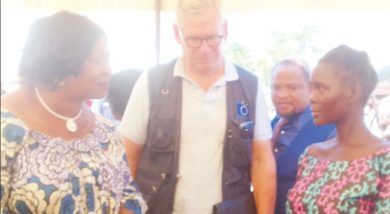Malawi to lose 55% Aids funding
 An official report says Malawi is set to lose 55 percent of its HIV and Aids funding in the next two years, a development that threatens the lives of one million people with the virus.
An official report says Malawi is set to lose 55 percent of its HIV and Aids funding in the next two years, a development that threatens the lives of one million people with the virus.
The report—which has projected resources for Malawi’s HIV and Aids programmes—says the end of funding from the Global Fund for Aids, Tuberculosis and Malaria (GFATM) next year has drilled the money hole, threatening the sustainability and upscaling of various HIV and Aids interventions.
Treatment and facility-based care, which takes up 57 percent of the country’s HIV and Aids budget, could be the hardest hit, according to the government report.
About one million people in Malawi, roughly 14 percent of the population, have the virus. Out of these, over 350 000 are on treatment, which is 60 percent of those who need treatment.
But the National Aids Commission (NAC), while confirming the shortfalls and the potential impact the deficit may have, said this week government is working on a strategy for mobilising resources domestically and cutting dependence on foreign aid to support HIV and Aids programmes.
NAC has also assured that those already on treatment will not be affected, but admitted that it may be hard in future to offer treatment for new cases due to the envisaged funding deficit.
Malawi’s HIV prevalence rate stands at 10.5 percent, down from 14.2 percent in 2000, according to the 2010 Malawi Demographic and Health Survey.
The report projects a gap of $128 million (K43 billion) from the current $212 million (about K72 billion) to $84 million (around K29 billion) in two years’ time.
It shows that while HIV and Aids funding in the 2012/13 fiscal year is planned at about K72 billion, the resources are projected to dwindle to $117 million (about K39 billion) during the 2013/14 fiscal year and later $84 million (about K29 billion) in 2014/15 fiscal year.
“Fifty-five percent of HIV funding in Malawi is at risk with the Global Fund grant ending in 2014… Snapshot of HIV funding in Malawi shows that 57 percent is allocated to facility-based care and treatment,” it says.
The report says the estimated decline in HIV and Aids funding comes at a time the country already has critical shortfalls in resources for ART, male circumcision (MC), Prevention of Mother-To-Child Transmission (PMTCT) and other interventions for high-risk populations.
“ART, MC, PMTCT and interventions for at-risk populations appear significantly underfunded…Some high-prevalence districts receive relatively little HIV funding,” it says.
The dwindling HIV and Aids funding levels have alarmed major players in the fight against the pandemic.
On Wednesday, Malawi Network of People Living with HIV and Aids (Manet+) executive director Safari Mbewe said the expected decrease in HIV and Aids funding is a major blow to almost all efforts the country has been making to fight the pandemic.
“If the situation is not checked in good time, the future looks scary and gloomy, especially considering that the treatment programme needs a lot of resources and that treatment is supposed to be for life,” said Mbewe in an e-mailed response.
The funding gap is more worrying now than ever considering that government is switching to the new HIV treatment regimen which is more expensive than the current regimen being abandoned for containing Stavudine largely blamed for body defects on users.
Asked what options government may have to avert the impending crisis, Mbewe said: “Government should demonstrate prudence in the use of the available resources to win development partners’ confidence, immediately engage various development partners seriously on post-2014 support, and intensify its own generation of locally available resources for the HIV national response.”
Malawi Health Equity Network (Mhen) executive director Martha Kwataine also urged financial prudence on Wednesday as a starting point.
“If we sealed loopholes of wastage and corruption, we can save good sums of money that can go towards HIV and Aids fight. Government should not do business as usual. It is time to re-prioritise our expenditure,” said Kwataine.
She suggested that in the next budget (2013/2014); government must start allocating funds for HIV treatment from its domestic revenue, explaining that donor priorities are changing because they too have financial problems of their own.
But NAC finance and administration director Washington Kaimvi said the Department of Nutrition and HIV and Aids is currently championing efforts to explore alternatives for HIV and Aids resource mobilisation which, he said, could help avert the crisis.
He said the country will soon develop a resource mobilisation strategy to enable it to raise resources for HIV and Aids fight locally.
“With that, we hope we will begin to reverse the trend on over-reliance on external resources for HIV and Aids,” said Kaimvi.
He added that the World Bank and the United Kingdom’s Department for International Development (DfID) have provided more resources to fight the pandemic, but said the support largely focuses on HIV and Aids prevention interventions and not treatment.
In the immediate term, Kaimvi said government has this week written the Global Fund requesting information about its next round of funding following the cancellation of Round 11 last year due to financial difficulties after key Global Fund donors changed positions on their pledges.
He, however, said people on treatment should not panic because after the end of Global Fund resources in June next year, Malawi will still access further support from the fund only to enable it to maintain provision of treatment for another two years.
“In as far as Global Fund is concerned, there is a provision that if Malawi does not mobilise enough resources either from another Global Fund round or other sources to continue with treatment after end of their grant in June 2014, they will continue supporting treatment for only those patients who will be on treatment at the time of the end of their grant for two years.
“They will do that because this is lifelong treatment and there is need for a safety valve to allow time for countries to look for more resources,” said Kaimvi, adding that within the two years, government will only be required to raise resources for new patients needing ARVs.
Ministry of Health public relations officer Henry Chimbali said resource decline is by nature going to impact on the ministry’s operations as regards HIV biomedical response (ART, HTC [HIV Testing and Counselling], STI, male circumcision).
He, however, said the ministry is convinced that the resource mobilisation strategy being led by the Department of Nutrition and HIV and Aids in the Office of the President and Cabinet will bear fruits.
Ministry of Finance spokesperson Nations Msowoya said government is optimistic that Malawi will get more funding from Global Fund’s next rounds.
He also confirmed that government is talking to other donors such as the World Bank, Norway, DfID and United States Agency for International Development (Usaid) to come in to help sustain implementation of HIV and Aids interventions in the country.
“We have a $50 million [K17 billion] grant from World Bank on various activities which NAC is implementing. There is also the $2 million [about K680 million] which the Malawi government contributes to the pool of HIV and Aids resources every year.
“We also have the two percent of every ministry’s budget which is allocated to HIV and Aids-related activities. As Treasury, we are very optimistic that something positive will come out of the Global Fund,” said Msowoya.





